For an artist, the genesis of any artwork is often a mystery,
but David Hewson has a greater sense of the origins of his
latest work than usual. The inspiration comes from his
powerful sense of the natural world.
A
year ago, Hewson read in a psychology magazine that people
react in a positive way to images from nature; there's a
tendency for the blood pressure to drop when they look at, for
instance, butterflies. In a word, people relax. This notion
stuck.
Shortly after this, First Health commissioned him to come up
with an idea for a huge space between the main entrance and
their Oncology Unit and he immediately remembered that
magazine. In Hewson's mind, butterflies had another
connection, too. They symbolised the regeneration of life; the
transformation from caterpillar to chrysalis to butterfly had
the aura of optimism he wanted to capture, the sense that an
end of one thing, is the beginning of another.
 The
scale of his idea was ambitious. There are three panels
filling over twenty feet, and that doesn't include a number of
butterflies flying freely from out of the work itself; instead
of paint, he used the entire colour spectrum of clays from the
earth - unprecedented in a work of this size; all dominated by
gilding in precious metals.
The
scale of his idea was ambitious. There are three panels
filling over twenty feet, and that doesn't include a number of
butterflies flying freely from out of the work itself; instead
of paint, he used the entire colour spectrum of clays from the
earth - unprecedented in a work of this size; all dominated by
gilding in precious metals.
The
overall effect is rich and layered. The natural, textured
blues of the clay allow the cosmos setting to be both
background and yet come to the forefront at times, enhancing
the ever-changing nature of time and the universe. And across
it, all the perpetual progression of the cycle of life,
chaotic, magical, mysterious, but ultimately comforting.
The
multi-coloured butterflies shine out from the work, creating
its real focus, set off perfectly by the golds, silvers and
platinums of gilding, a technique Hewson learned during a
seven year apprenticeship in Italy.
Bernard Clark